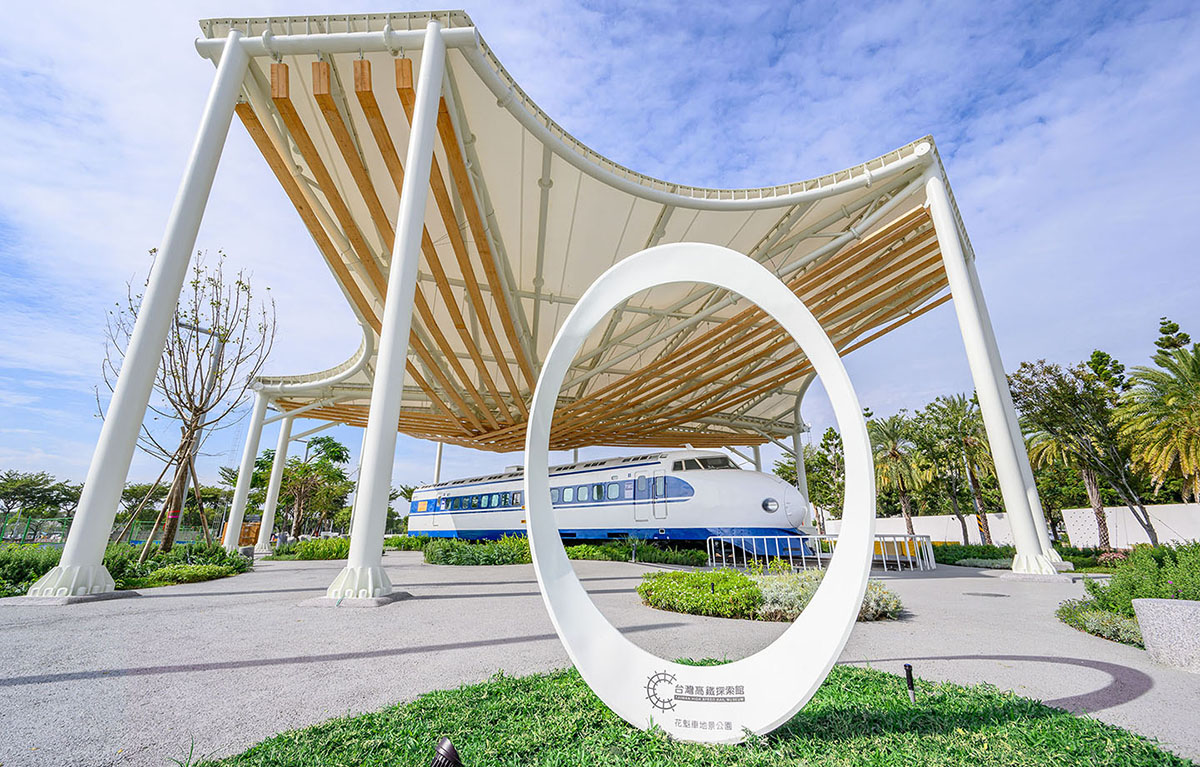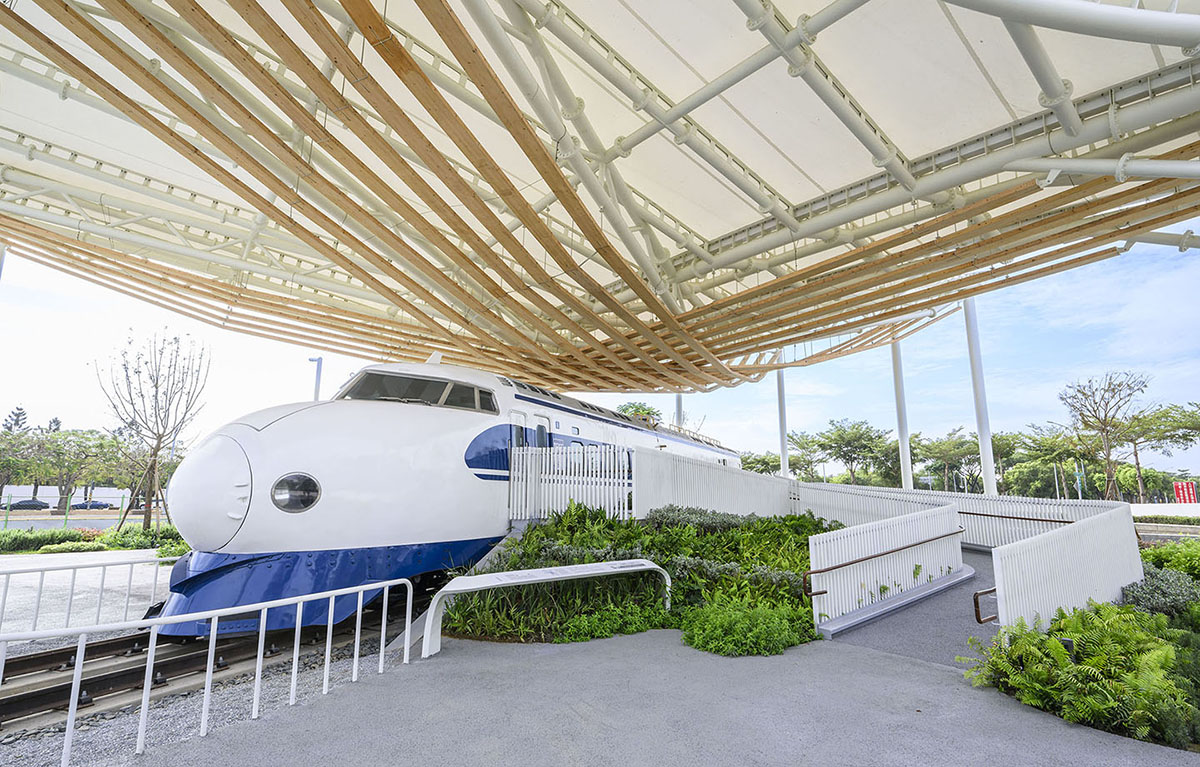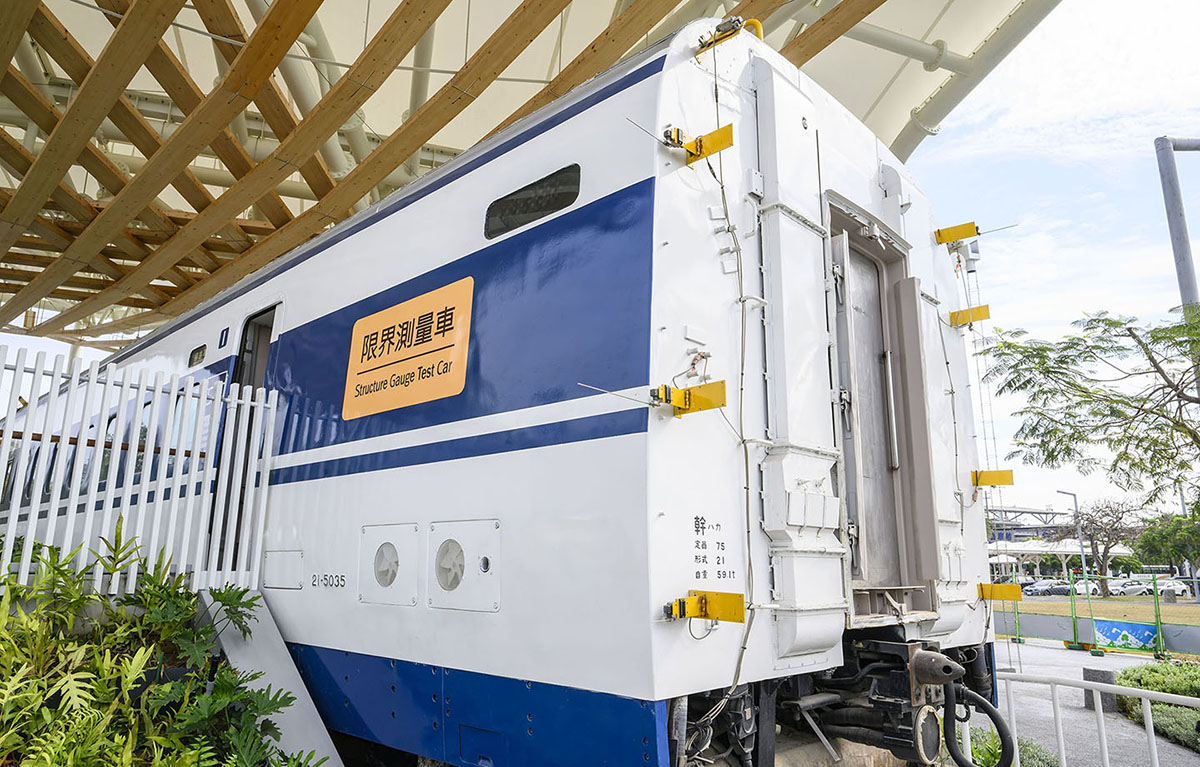Tainan exhibition area - Oiran Train
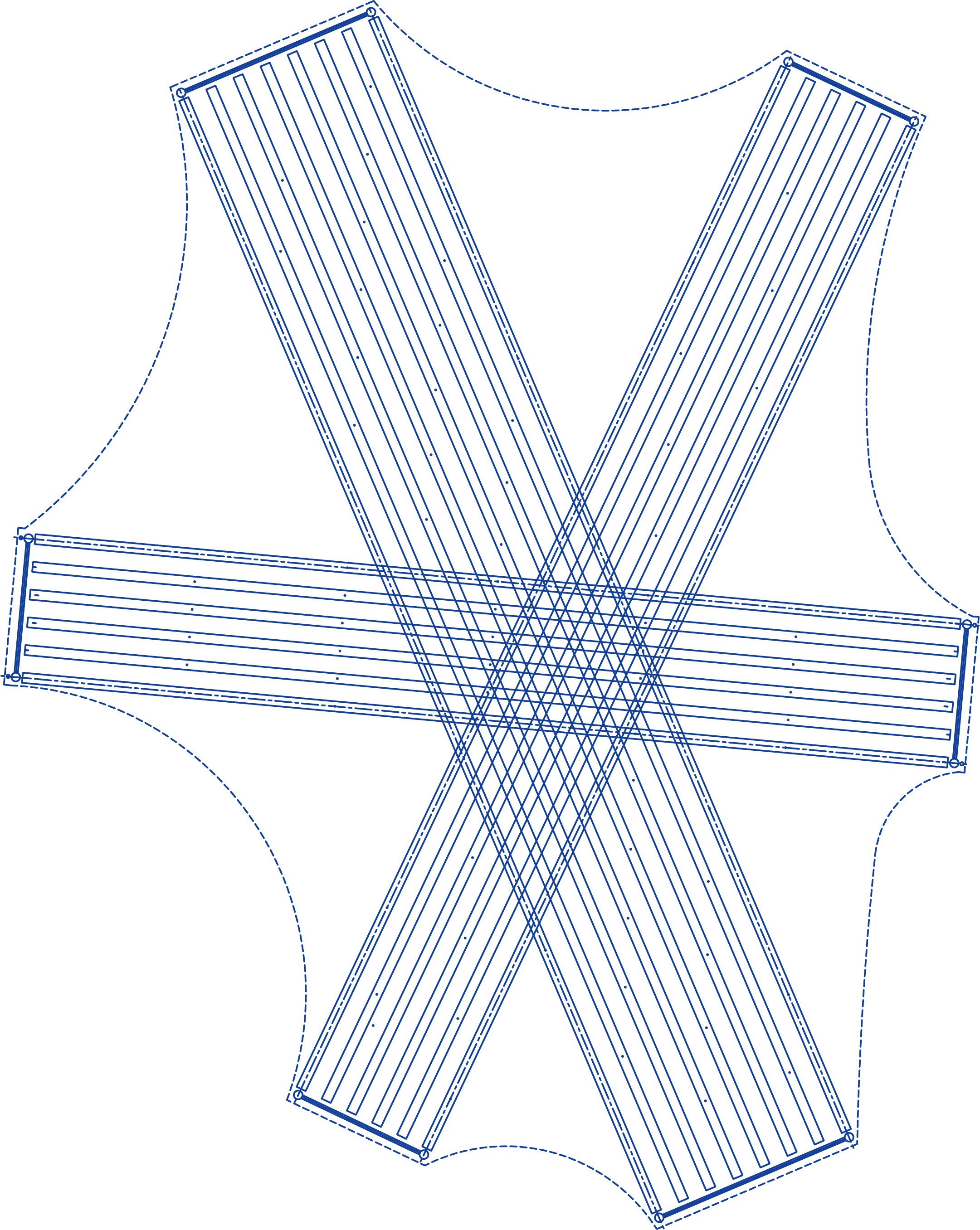
Reappearance of The Classic “0 Series Oiran Train”
Oiran Train Scenic Park
Taiwan High Speed Rail Corporation (THSRC) is a forerunner in preserving Taiwan's railway cultural heritage. Since the construction of Taiwan High Speed Rail (THSR) in 2003, we have been collecting, studying, and preserving objects that have historical significance. In 2017, THSR Museum was established and located in the THSR Operation Management Center in Taoyuan. As the first THSR museum, its mission is to promote Taiwan's high speed rail technology and the humanities and history education. Ever since the world's 1st generation high speed train, “0 Series Oiran Train,” becomes one of its collections, THSR Museum is taking a greater responsibility in the preservation, conservation, and inheritance of world's railway culture and legacy.
In Oiran Train Scenic Park, with 0 Series Oiran Train at the center, the development element in exploring 0 Series Oiran Train can be extended limitlessly. This is where the story of 0 Series and THSR to be told. The building structure consists of 3 sets of hanging wood beams. The crossing wood beams form a radial pattern, symbolizing the shape of Railway Roundhouse. The Park is also the first public area where THSRC displays trains as exhibit.
World's 1st Generation High Speed Train “0 Series” in Taiwan
In August 2007, the Shinkansen trainsets in Japan were listed as a Japan's Mechanical Engineering Heritage for being an achievement of mechanical engineering, and had brought revolutionary and enormous change and contribution to human's transportation and lifestyle. After 44 years of operation, 0 Series Shinkansen trainsets were retired in 2008.
This 0 Series train (Vehicle Number 21-5035, formerly 21-1032) was the first high speed trainset in the world. It was a gift from West Japan Railway Company to TSIEC, the contractor of Taiwan High Speed Rail's E/M core system. The 0 Series train known as “Oiran Train,” was transported to Taiwan in 2004 and was used as structure gauging car during the construction of Taiwan High Speed Rail. Upon the completion of its mission, TSIEC donated the “0 Series Oiran Train” to THSRC. It officially became a high speed rail cultural heritage and was collected by THSR Museum in 2012. It is also one of the two 0 Series trainsets preserved outside of Japan.
After surveys and repairs, 0 Series Oiran Train is destined to settle down in the Taiwan High Speed Rail Museum – Oiran Train Scenic Park at HSR Tainan Station. The intention is to display 0 Series train's innovative technology and achievement as it was the forerunner of high speed train, and that it was locally used for derivative purpose in Taiwan. Other than having a second life in Taiwan, 0 Series train also became a part of Taiwan's high speed rail culture and history.
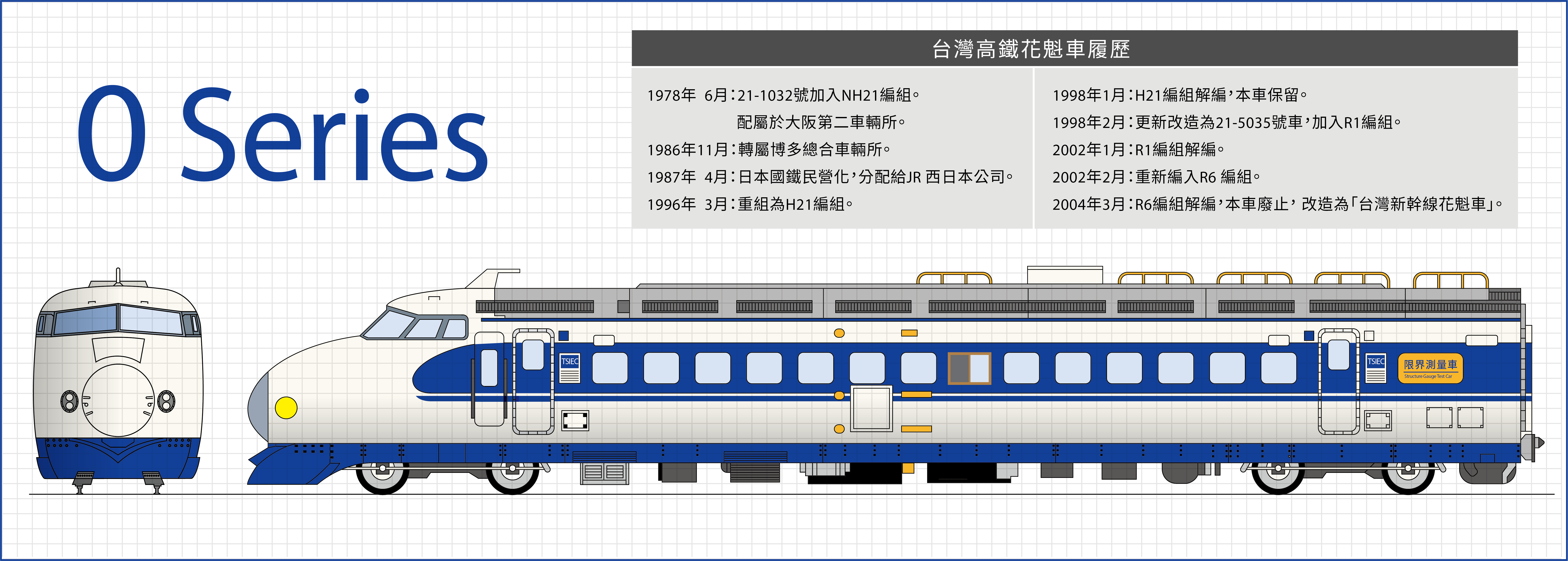
History of THSR Oiran Train
| June 1978: | Vehicle Number 21-1032 marshalled into NH21 group under Osaka SecondRolling Stock Center. |
| November 1986: | Transferred to Hakata General Rolling Stock Center. |
| April 1987: | Distributed to West Japan Railway Company after the privatization of Japanese National Railway. |
| March 1996: | Marshalled into H21 group. |
| January 1998: | H21 group disbanded, train was kept. |
| February 1998: | Renovated and numbered 21-5035. Marshalled into R1 group. |
| January 2002: | R1 group disbanded. |
| February 2002: | Marshalled into R6 group. |
| March 2004: | R6 group disbanded. Retired and renovated to “Taiwan Shinkansen Oiran Train.” |
THSR's Cultural Heritage Preservation
Why called the “Oiran Train”?
Structure gauging car was also called “Oiran Train” in Japan. As the car was used for structure gauging and track testing, measuring instruments had to be installed outside of its body. The probes would extend to outside of car body during a gauging run, which made it looked like an oiran's hairstyle with hairpins on top of it. This was where the name “Oiran Train” came from.
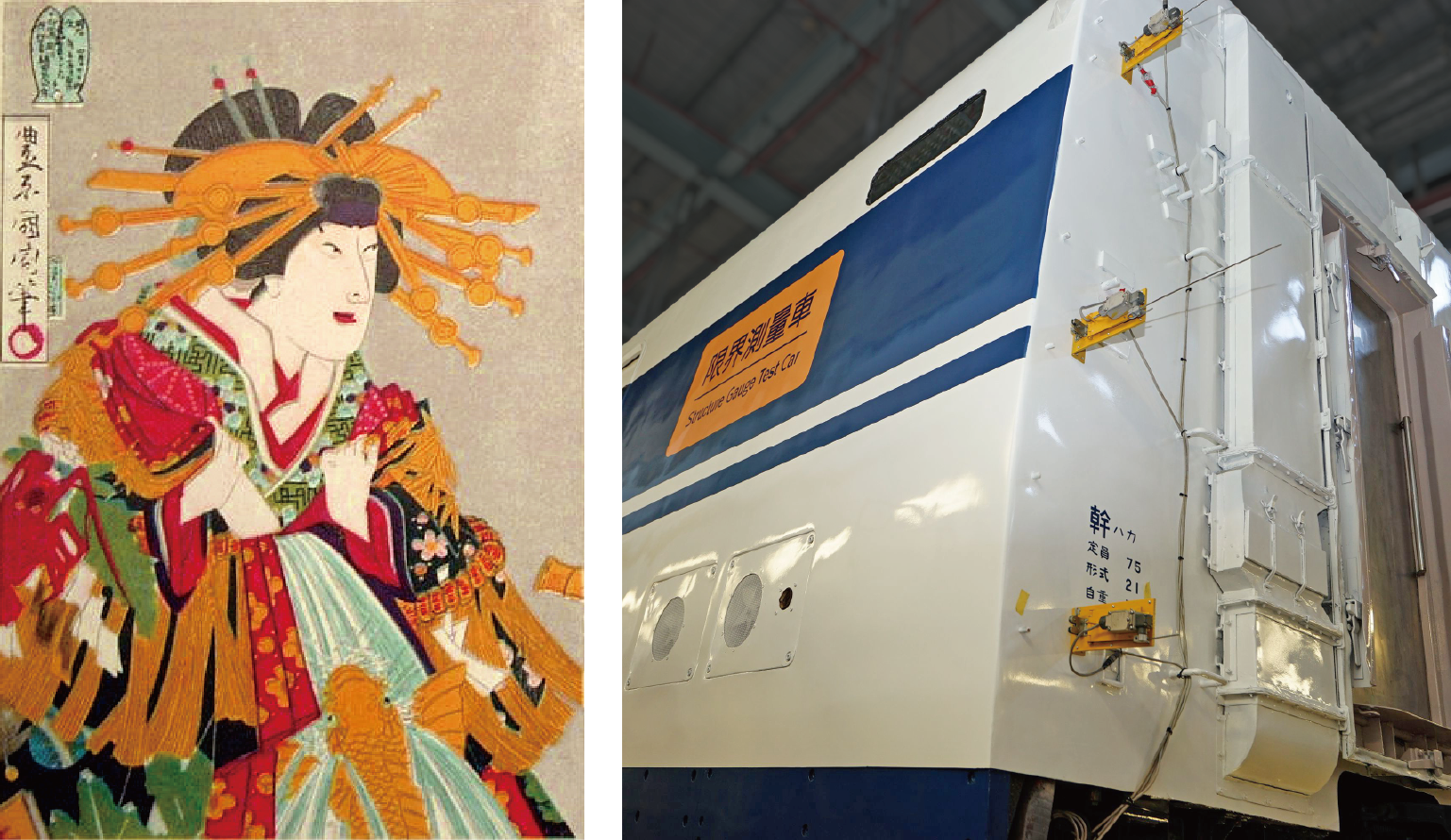 Image Source/Wikipedia Common
Image Source/Wikipedia Common
Life story of 0 Series Oiran Train
The 0 Series Oiran Train preserved by THSRC was the cab of retired 0 Series (Vehicle Number 21-5035) that belonged to the 1000 series. Finished manufacturing on June 19, 1978 by Tokyu Car Corporation, they were the 25th batch of Shinkansen trains and were equipped with small windows. According to the name plate on the train, the cab was renovated and became structure gauging car in 1998 by Hakata General Rolling Stock Center of JR-West. It arrived in Taiwan on July 16, 2004 to participate in the construction of THSR and was used for structure gauging to ensure that HSR could run fast and safe.
Restoration Project and Documentary
After 0 Series Oiran Train retired from the structure gauging car mission, it was temporarily preserved at HSR Liujia Depot in Hsinchu. However, even after a few times of basic maintenance, it still could not resist the damages brought by the power of nature. For the preservation and inheritance of such a railway cultural legacy, the National Science and Technology Museum, railway specialists, and cultural heritage conservation groups had conducted many studies and research and proposed a Riga Charter-based restoration project in 2018. The restoration project kicked off in 2019. The objective is to restore 0 Series Oiran Train's appearance and internal decoration based to the status during its service from 2004 to 2006.
Note 1: The Riga Charter provides the principles for later generations on the decisions made in regard to the conservation, restoration, maintenance, repair and use of historic railway equipment, which can still be operated, including the buildings or infrastructure that are parts of the railway system.
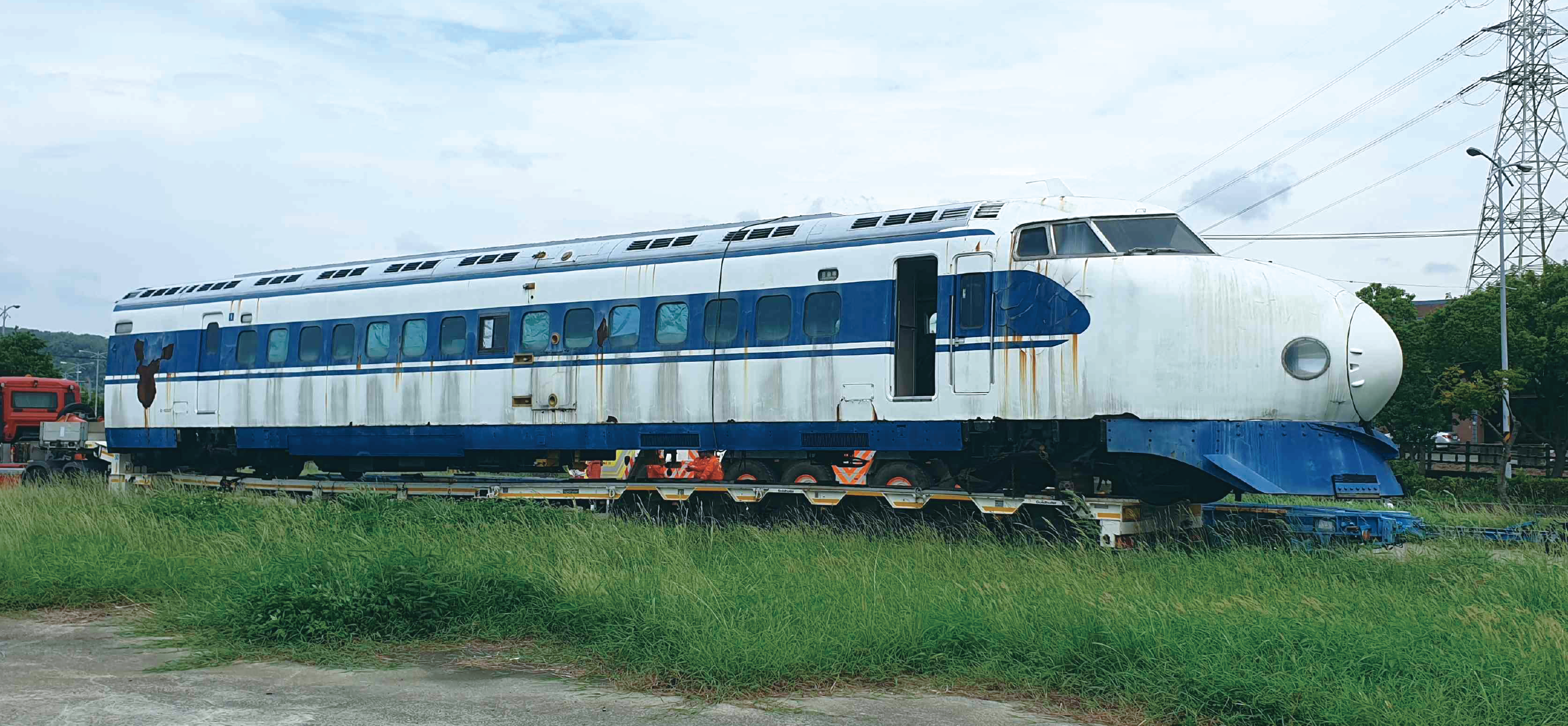 Before restoration project, 0 Series Oiran Train was preserved temporarily at HSR Liujia Depot in Hsinchu.
Before restoration project, 0 Series Oiran Train was preserved temporarily at HSR Liujia Depot in Hsinchu.
During the restoration work of the 0 Series Oiran Train, the items to be restored ranged from the inside and outside of the car, including car body, coating, signals, pedals, and pilot. Its windows and headlights also needed descaling and polishing. After the cut-off, coating removal, and rust removal of those rusted parts, the train's smooth appearance was secured with precision welding or replacement with new stamping parts. For car body coating, the 0 Series’ classic colors, Blue No. 20 and Cream No. 10, were chosen. The team duplicated, or paint sprayed the numbers and signals on car body based on original fonts and pattern. Inside the car body, they cleaned up and organized the inner part by rebuilding control panel and renovating driver's seat.
After two years of work, the 0 Series Oiran Train restoration project was completed in December 2019. The project became a model for legacy train maintenance and preservation.
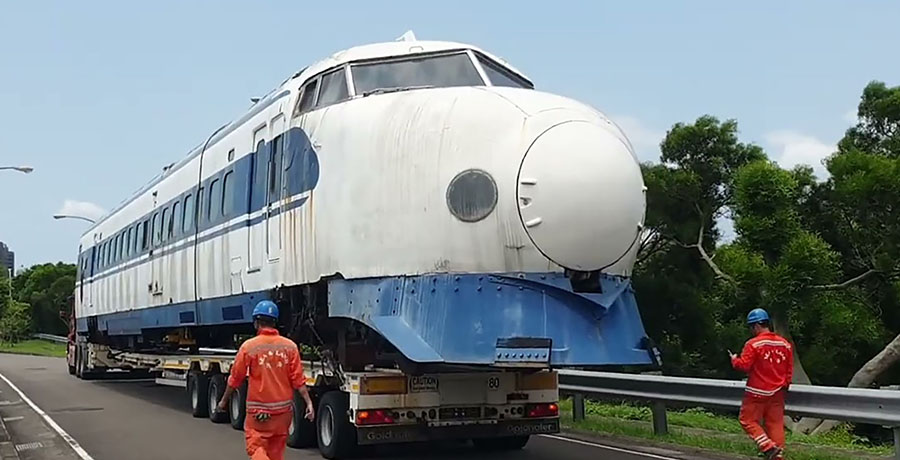

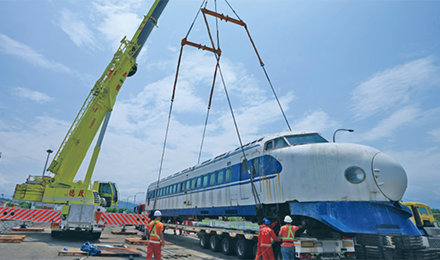 Hanging operation at HSR Liujia Depot in Hsinchu
Hanging operation at HSR Liujia Depot in Hsinchu
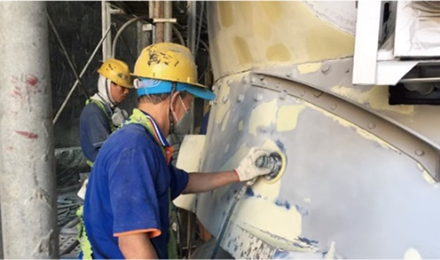 Restoration: Filling with putty and making the surface smooth.
Restoration: Filling with putty and making the surface smooth.
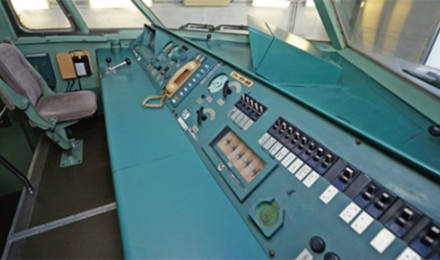 After restoration
After restoration
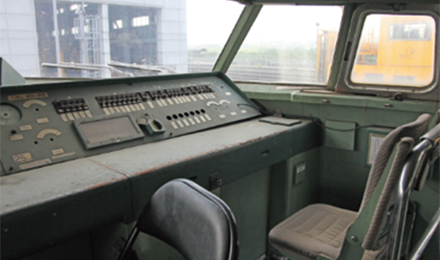 Before restoration
Before restoration
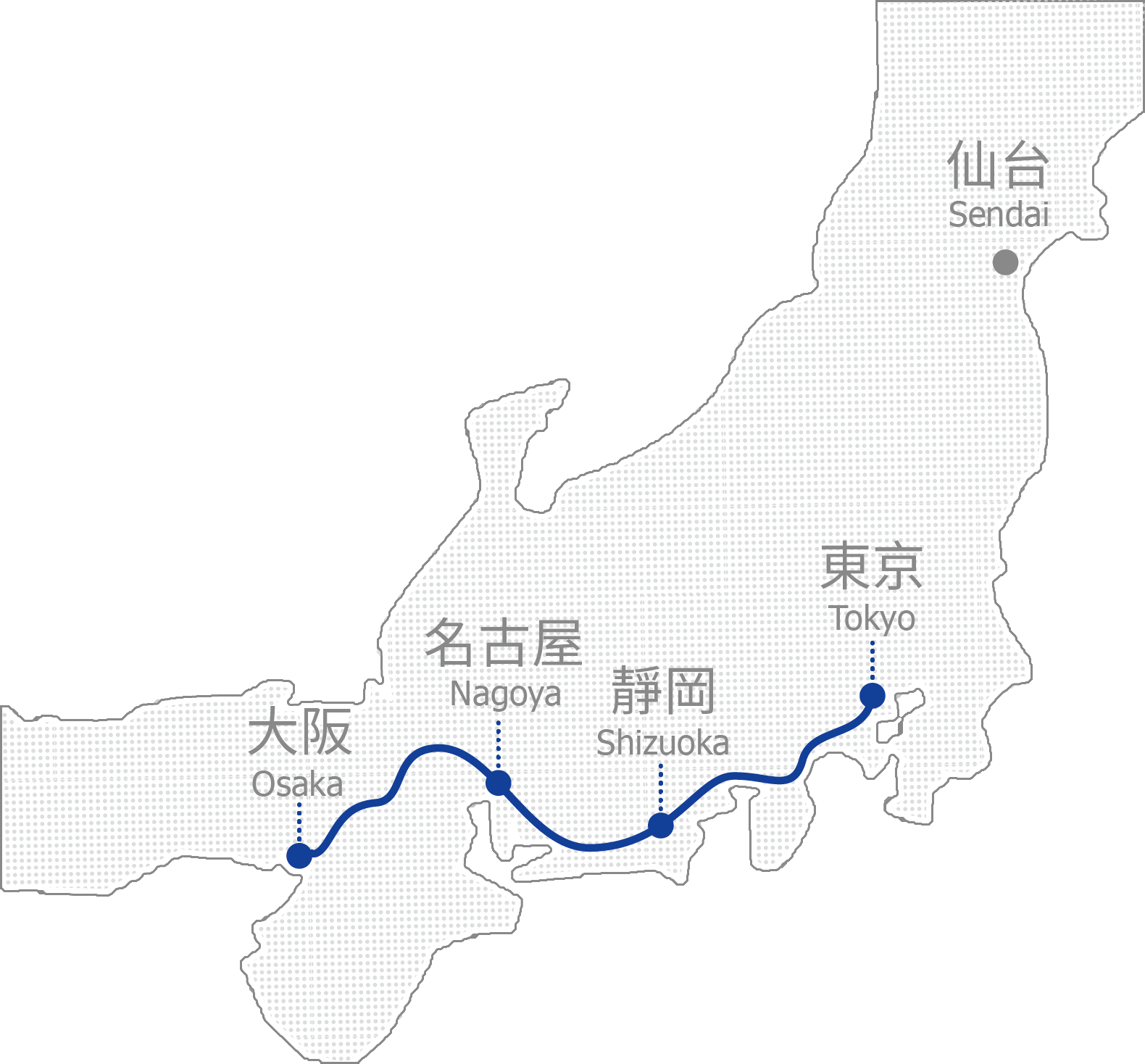
Birth of 0 Series Shinkansen
“0 Series Shinkansen,” A Legendary Forerunner of World's High Speed Train
The 0 Series was a great achievement of Japan's railway technology. It entered service on October 1, 1964, right before the opening of Tokyo 1964 Summer Olympics, significantly shortened the travel time between Tokyo and Osaka from 7 hours to 4 hours. Admirably, its maximum speed reached 210 km/h in the second year of its service.
The 0 Series Shinkansen had been in service for 44 years before its retirement in 2008. There were 0 accidents during its service. Such success in railway technology was also an inspiration to the development of TGV in France and ICE in Germany, which came in service in 1981 and 1991, respectively. The 0 Series Shinkansen's innovative technology redefined people's life and how business and economy worked.
Naming of “0 Series Shinkansen”
Shinkansen uses standard-gauge rail of 1,435 mm. The name Shinkansen (meaning, new main line) meant to differentiate itself from Zairaisen (meaning, conventional line). “0 Series Shinkansen” used to be simply as “Shinkansen.” Its official internal name was “000 Series.” The name “0 Series Shinkansen” was confirmed when the “200 Series Shinkansen” entered service in Tohoku Shinkansen line and Joetsu Shinkansen line.
Design of “0 Series Shinkansen”
In the late 1950s, with the gradual recovery of the Japanese economy, demand for high speed transportation became a desperately need; especially the transportation between the Special Wards of Tokyo and Osaka City. Right after the establishment of Tokaido Shinkansen line's construction, Japanese National Railways (JNR) President, Shinji Sogo, appointed JNR's Chief Engineer, Hideo Shima, to oversee the building of Tokaido Shinkansen.
Innovative distributed power system and alternating current (AC) model
In the early days of railway development, “concentrated traction system” that had locomotive driving the trainsets was the mainstream. However, Hideo Shima came out with this revolutionary idea to install distributed power system on each car. The new design could equalize the load onto roadbed from each car, which was a better solution for Japan's fragile geologic structure. Moreover, it could also lower the cost of construction and track maintenance.
Under the leadership of Shinji Sogo and Hideo Shima, Japanese National Railway started the research and development of new type EMU with distributed power system. As a result, Shinkansen became a fast and powerful electric train. Furthermore, Japanese National Railway invented the AC system adapted on high speed rail for the first time a more efficient system compared with the DC system, which commonly used on the international electric trains.
Design of Streamlined Bullet Train
The 0 Series train had a car length of 25 meters and width of 3.4 meters. The car floor was 1.3 meters above the ground. Its body was made of steel and the average weight of each car was as heavy as 64 tons. The 0 Series train was famous for its airplane cockpit-like cab and the bullet-shaped train nose. The design came from Tadanao Miki. Based on his experience and principle in aircraft design, the light-weighted and high speed car challenged the seemingly impossible speed of 160 km/h. The avant-garde streamlined and bullet-nosed appearance also contributed to reduction of air resistance. The speed of 0 Series reached 210 km/h, almost as fast as the aircraft by that time.
Design of Car Coating, Demonstration of Pop Culture At That Time
The coating of 0 Series’ body was inspired by the aircraft from Pan American World Airways (Note 2) and the package of hi-lite tobacco. It was coated in white with a blue stripe along the windows. White and blue represented cloud and blue sky. The blue was later used exclusively on Shinkansen trains. The design and coloring of 0 Series’ body were the demonstration of technology and mainstream pop culture of the 60s.
Note 2. Before its collapse in 1991, Pan American World Airways (Pan Am) used to be the leading international air carrier since the 1930s. It was a cultural image of the transportation industry in the 20th century for its widespread use of jet airliners and jumbo jets, and the innovative computerized reservation systems.
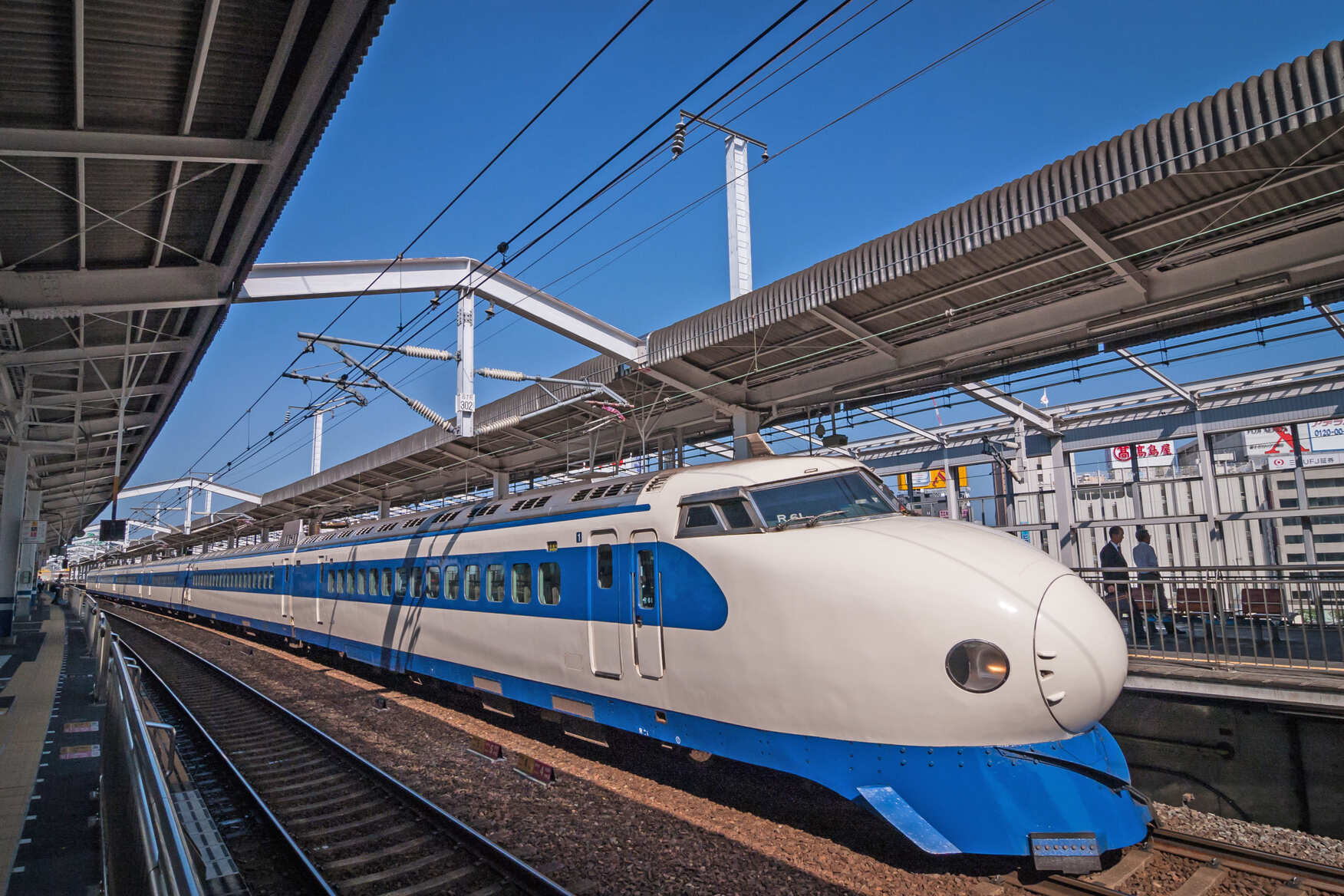 Picture provided by / Chen, Ying-Torng
Picture provided by / Chen, Ying-Torng
Deep Look at Oiran Train
A deep look at the Oiran Train and it's structure gauging mission
During the construction of THSR, the minimum distance to railway platform, tunnels, and bridges along the track needed to meet the structure gauge regulations. After construction, it was time for structure gauging car to make sure that there would be sufficient clearance.
Being used as structure gauging car, the 0 Series Oiran Train took the responsibility to check train station structure, platform, bridges, and tunnel structure and make sure that there would be sufficient clearance for high speed train to get past safely.
To ensure safe clearance along the line, Hakata General Rolling Stock Center in Kyushu, Japan renovated this 0 Series train. A part of the seats in passenger cars were removed for the installation of gauging equipment. They also installed a roof observatory for technicians to monitor outside situation. Outside the train, there were probes and ultrasonic sensors surrounding the car to gauge the distance between structure gauge and loading gauge and to make sure no obstacles were on the way. Since 0 Series Oiran Train did not have its own power when imported to Taiwan, it had to be driven by the DD14 diesel-hydraulic locomotive during gauging tasks.
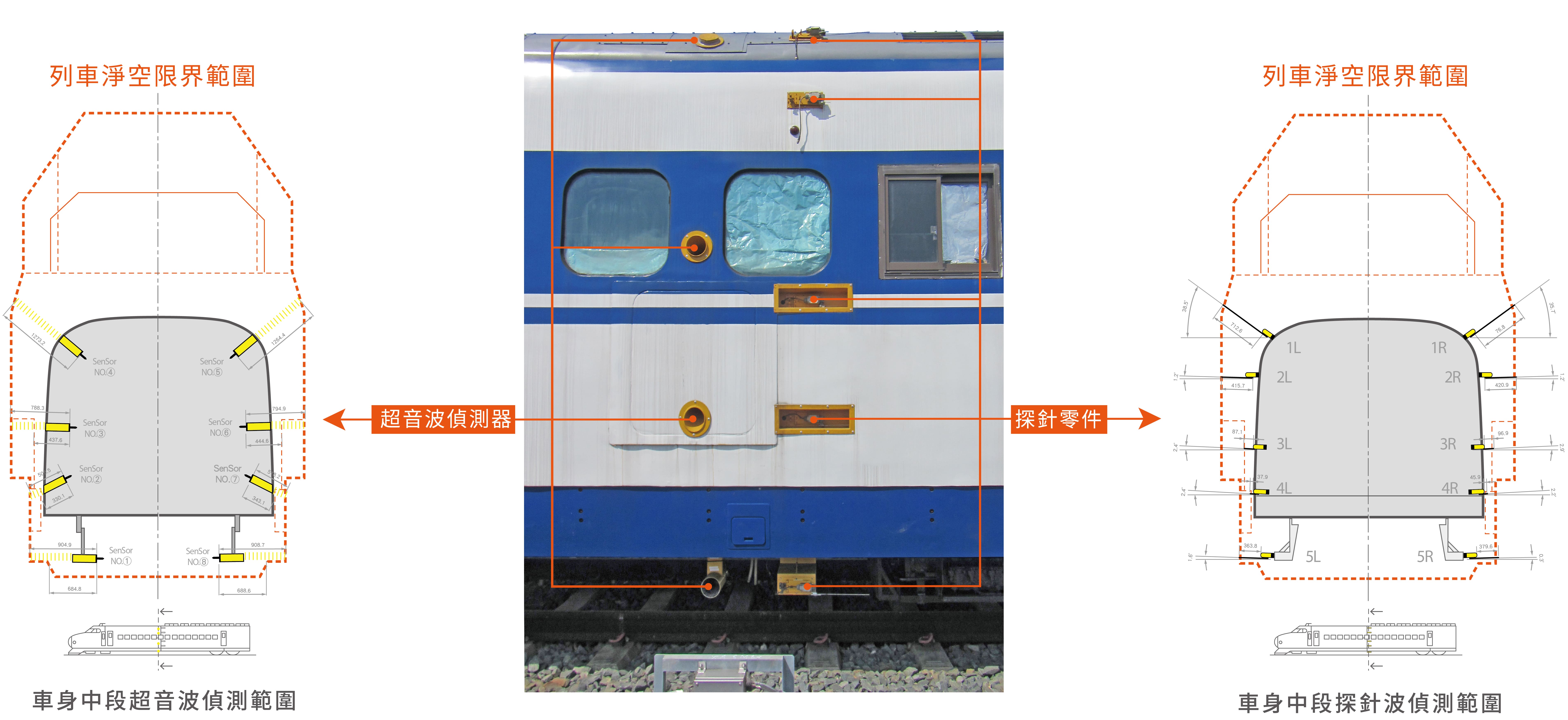
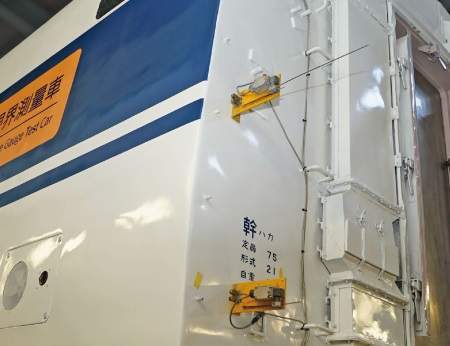 Limit switches
Limit switches
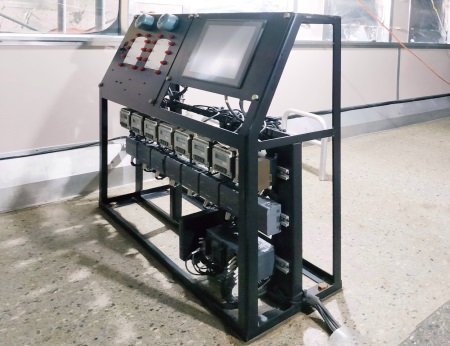 Test recording rig
Test recording rig
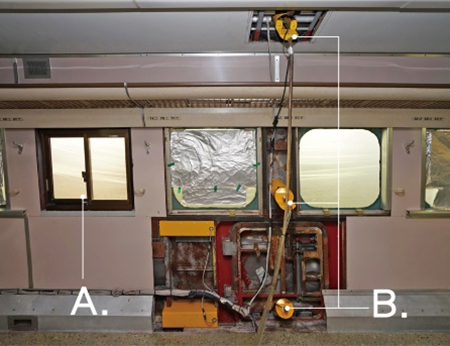 A.Openable window B.Ultrasonic sensor
A.Openable window B.Ultrasonic sensor
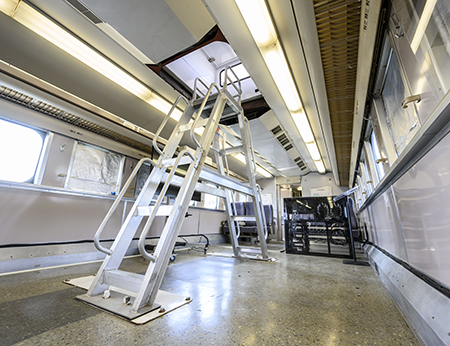 Observation hatch
Observation hatch
Types of Railroad Roadbed
Considering there are different geologic structures along the THSR line and for the purpose of providing the safest and most comfortable ride, different railroad roadbed designs were adapted, including J-SLAB, Rheda, LVT, Ballast Track, and the Embedded Rail System that was adapted only at Taipei Station.
J-SLAB
Japanese type J-SLAB is adapted at bridge sections as both Taiwan and Japan suffer from earthquake. The Japanese slab track consists of concrete slab placed on the bridge and joint by cement asphalt mortar. The construction of J-SLAB is efficient and of high-quality. Around 80.9% of THSR track adapts J-SLAB roadbed. (J-SLAB is also the track exhibited at the scenic park.)

Rheda 2000
The roadbed close to and inside the station adapts Rheda 2000. The turnout positioning of Rheda 2000 is precise. Along with the use of railroad switch, it provides the safest mechanism. Around 14% of THSR track adapts Rheda 2000.
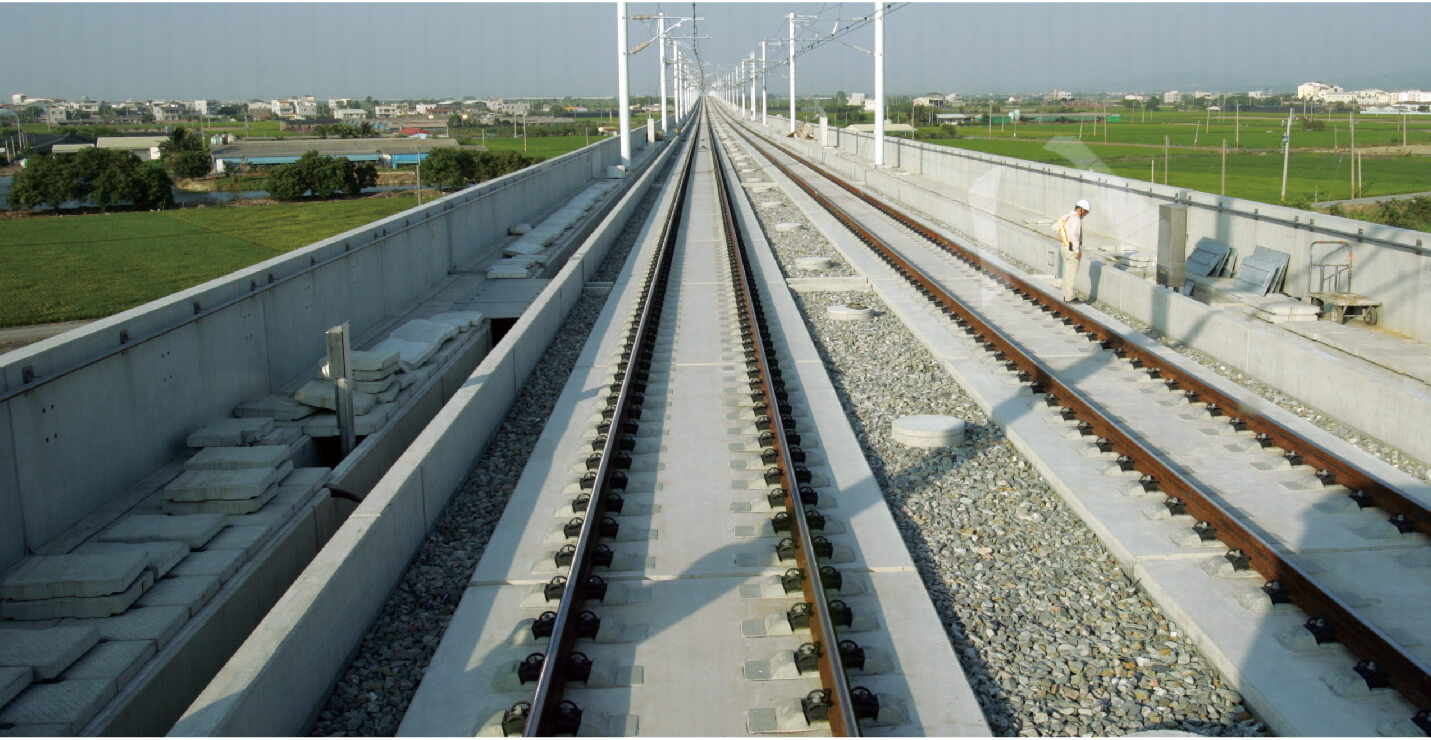
Low Vibration Trackform, LVT
THSR track between Banqiao and Nangang was built underground to avoid vibration and noise that might affect the residents when the T700 train passing through Taipei Metropolitan Area. Hence, Low Vibration Trackform (LVT) was adapted. The two layers of rubber mats under slab absorb the load from running train and reduce vibration and noise. Around 3.6% of THSR track adapts LVT.
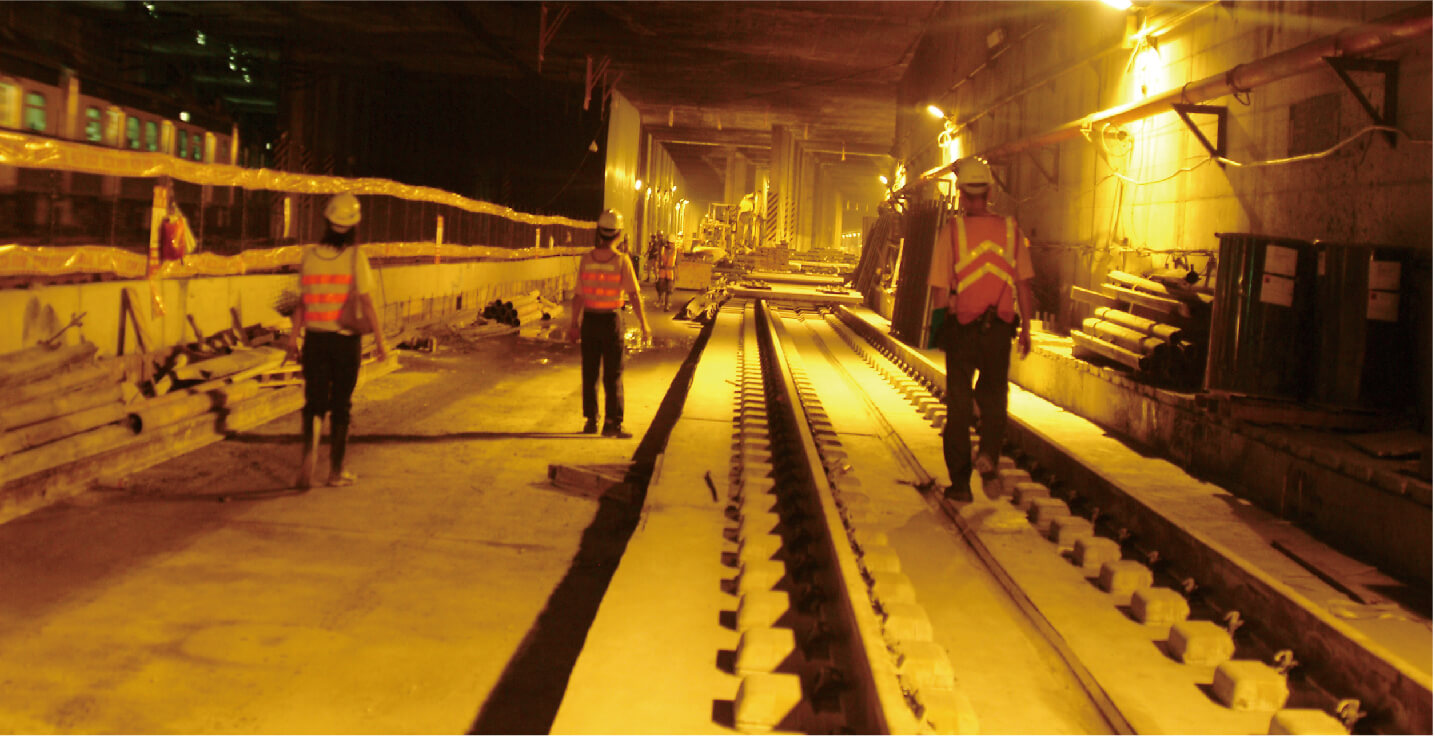
Ballast Track
Ballast is used to bear the load from the railroad ties and to facilitate drainage of water.
THSR only adapts Ballast Track in a few parts of the track in flat region, e.g. HSR Zuoying Station and Zuoying Depot. When running on flat area, this is to reduce creating noise that affects residents nearby.
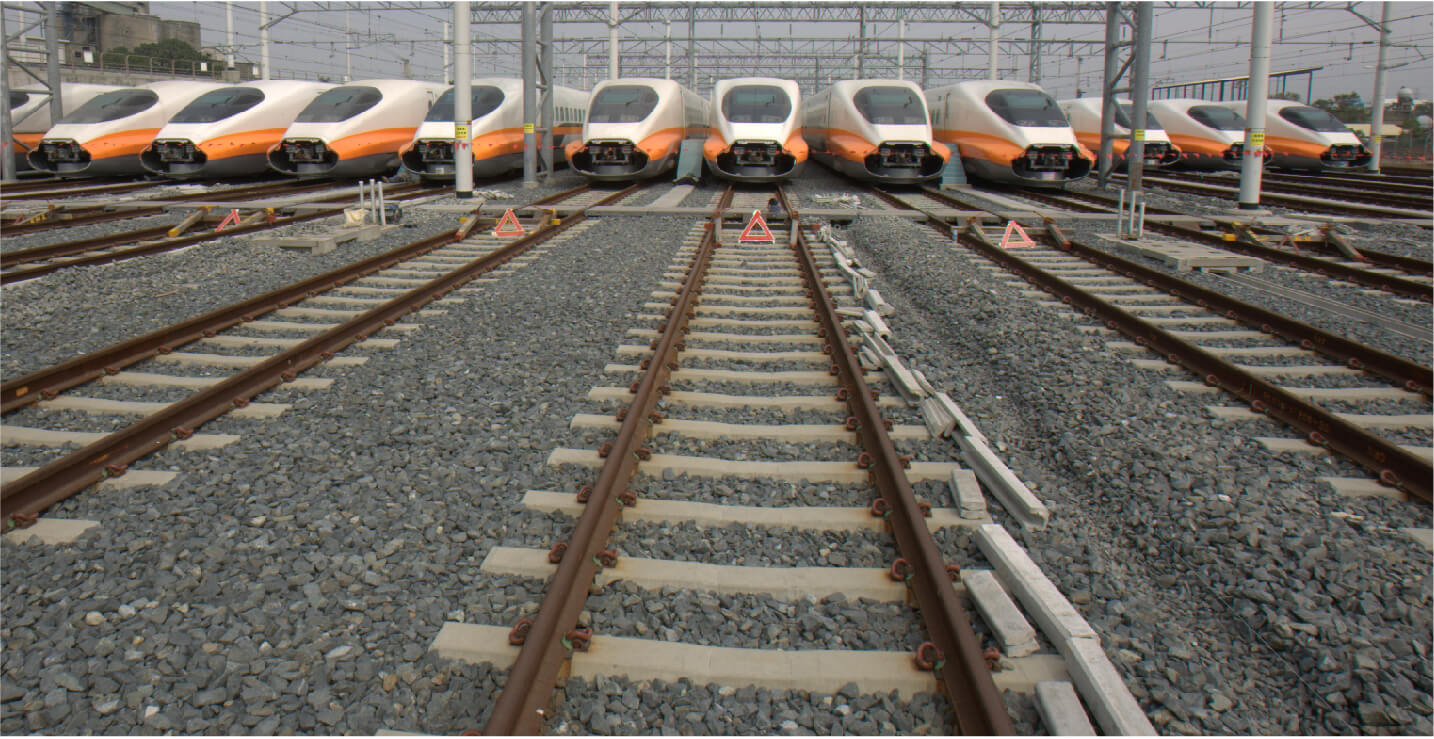
Development of Taiwan's Railway Technology
Taiwan Railway has had various types of trains, including saturated-steam locomotive in early days, the improved superheated-steam locomotive that motived more kinetic energy, Diesel Rail Car (DRC) with distributed power, diesel electric locomotive, and then electric locomotive.
Taiwan railway's power technology has transformed from steam engine, diesel engine, to electric motor. Finally, the quiet and fast Electric Multiple Unit (EMU) show its appearance. The THSR 700T is also an EMU trainset with a maximum speed of 300 km/h and established the “one-day living circle” along Taiwan's western corridor. From 30 km/h to 300 km/h, the efficiency, performance, and service of railway have been improved continuously. The advancement of railway technology is a part of Taiwan's history and is also in the memory of Taiwanese people from each generation.
Tengyun/Cloud Rider (Speed:35 km/h) - Entered service in 1888
#Taiwan's first steam locomotive
Taiwan's first steam locomotive, manufactured in Germany. There were two locomotives of the same type imported to Taiwan to join railway's construction from initial stage. Later, they became tractor trailer trains for passenger and freight. After its retirement in 1924, it has been a collection in the National Taiwan Museum due to its historical significance.
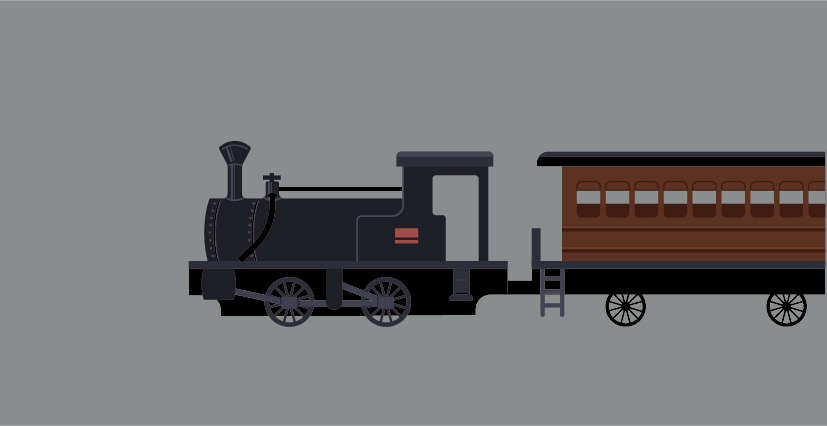
Type No. 18 (Speed: 35 km/h) - Entered service in 1901
#Attempts of Japanese-manufactured locomotive in the early days.
Type No. 18 series were one of the earliest "localized” products after Japan started to build locomotive. The design was based on Britain's Type A4 steam locomotive, which was why the building of No. 18 series involved many manufacturers from both Britain and Japan. They were one of the major steam locomotives used in Taiwan during the 1900s to 1920s. After World War II, the series was renamed BK10 by Taiwan Railways Administration.
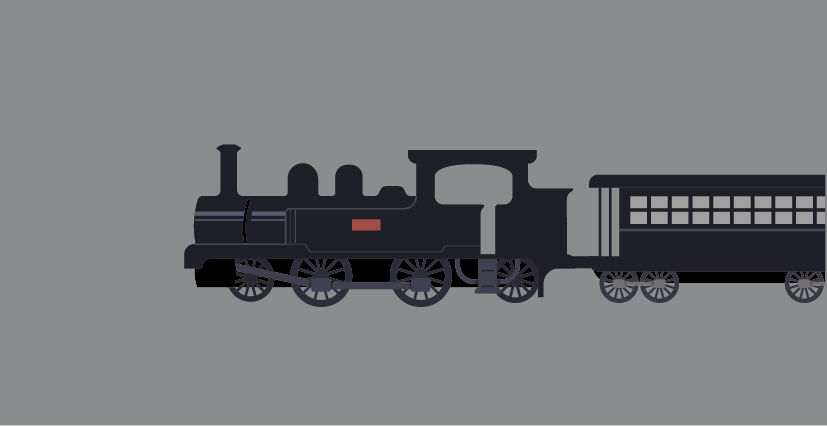
Type 500 (Speed: 75 km/h) - Entered service in 1919
#Masterpiece during Taisho period
Developed, designed, and manufactured by Japan, Type 500 and Type 800 of the same generation were called the “Two Stars in Taisho Period,” representing the success of Japanese train building industry. Since the 1920s, Type 500 was renamed Type CT150 after World War II, served as the express trains in Western Line until railway electrification.
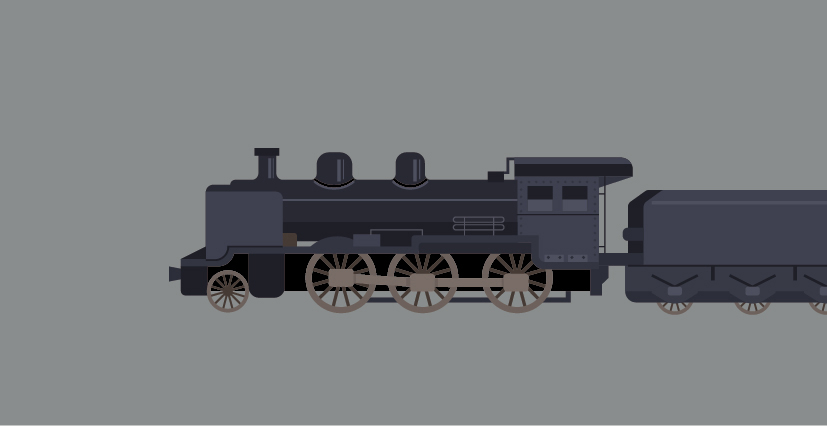
Type C55 (Speed: 85km/h) - Entered service in 1935
#Era of the faster streamliner.
Type C55 series were built with mature steam locomotive technology and welding technique was widely applied on the train's structure. They adapted all-in-one steam dome and sandbox above their boiler. Compared with former design, they had streamline and modern outlook. However, their driving wheel still adapted convergence type as former design. After World War II, the series was renamed Type CT250.
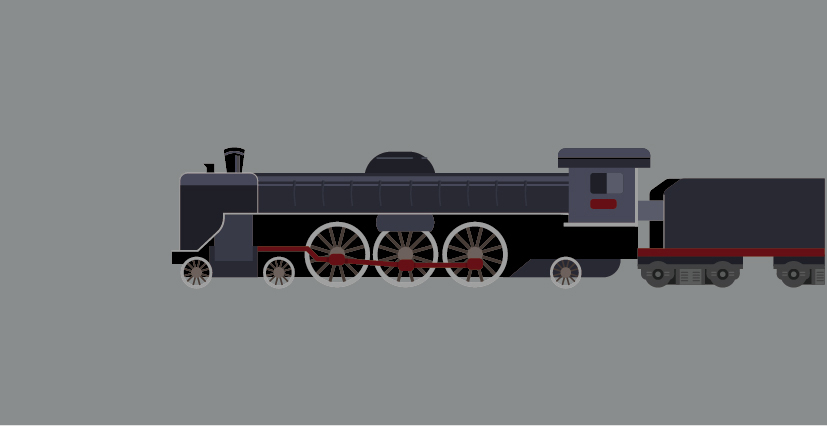
Type DR2500 (Speed: 105 km/h) - Entered service in 1955
#Round trip between Taipei and Kaohsiung in one day became possible.
After World War II, TRA replaced the gasoline engine with diesel engine and found its performance satisfactory. In addition, with the aid from the United States, there was notable improvement in track and signals. Hence, TRA purchased new Diesel Rail Cars in 1995, which set the record of only 5.5 hours of travel time between Taipei and Kaohsiung. The name of Diesel Limited Express became widely known.
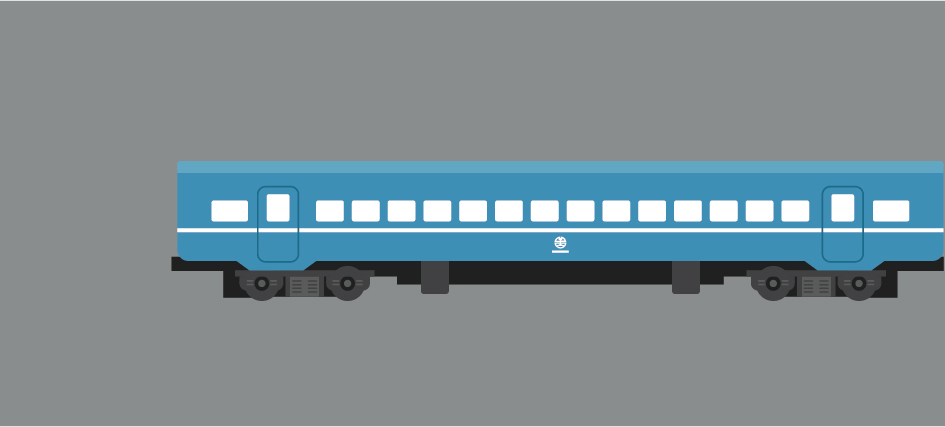
Type R20 (Speed: 100km/h) - Entered service in 1960
#First Diesel-Electric Locomotive serving in Western Mainline.
In the late 1950s, TRA started to replace original locomotives with diesel ones. The R20 series, built in the U.S., were among the earliest batches. Diesel-Electric Locomotive was driven by the traction motor, which was powered by diesel engine. It had much better energy efficiency and produced less air pollution compared with steam locomotive.
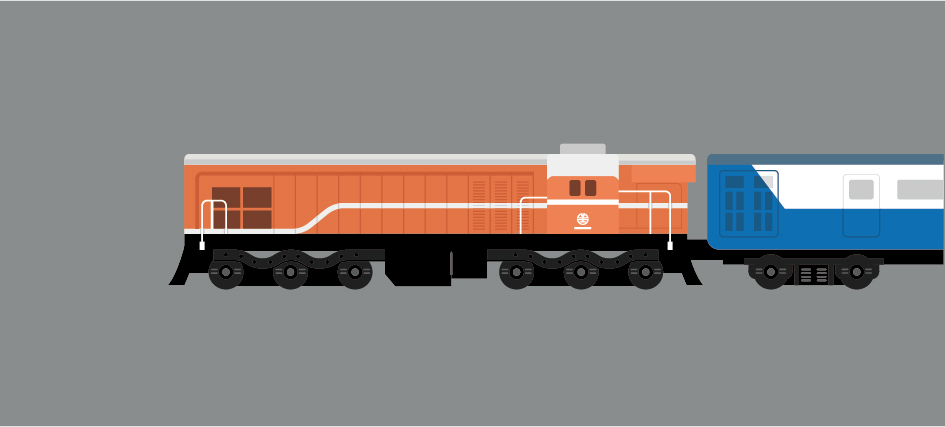
Type DR2700 (Speed: 110 km/h) - Entered service in 1966
#Fastest train before railway electrification
Type DR2700 series was the successor of Diesel Limited Express (DR2500 and DR2600). Although they were built in Japan, the design was based on Budd's (U.S.) Rail Diesel Car (RDC). They had stainless steel body and big radiator on top of car. When they entered service in 1966, they were named “Kuang Hwa.”At that time, they were the fastest land transportation that took only 4 hours and 45 minutes to travel between Taipei and Kaohsiung.
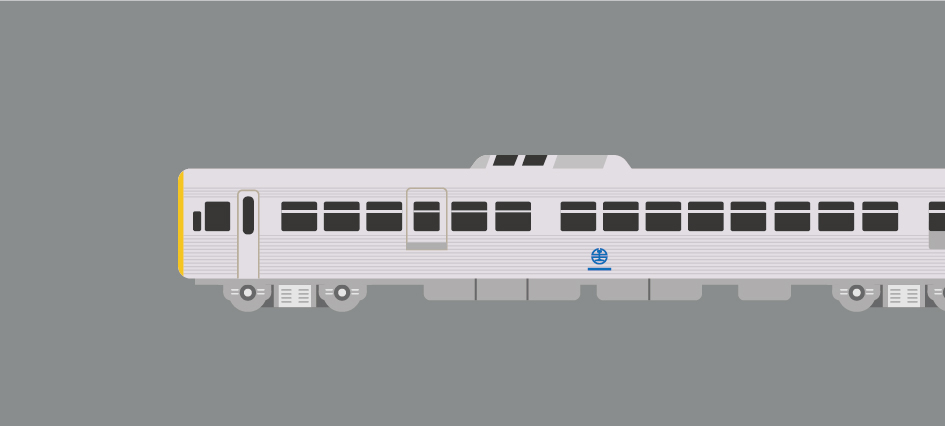
Type EMU100 (Speed: 120 km/h) - Entered service in 1978
#First Electric Multiple Unit (EMU) in Taiwan
During the electrification of Western Line, TRA imported many types of electric trains. Type EMU100 series were the first EMU in Taiwan. For the first time, the operating speed reached 120 km/h. Other than speed, this series was equipped with air conditioning and high-end decoration, which made it a milestone of Taiwan Railway services.

Type TEMU1000 (Speed: 140 km/h) - Entered service in 2007
#First Tilting Electric Multiple Unit in Taiwan
In Taiwan, there are many curves on Eastern Mainline, creating limitations for train operation. Hence, TRA imported the “Tilting EMU Trainsets” (TEMU1000) in 2006 and named the series “Taroko Express.” By tilting the cars, the motion would be smoother and more comfort when a train rounds a curve at speed.

Type 700T (Speed: 300km/h) - Entered service in 2007
#THSR one-day living circle
The 700T is Taiwan's first high speed train. Since the commercial operation of THSR on January 5, 2007, travel between Taipei and Kaohsiung has been shortened to 90 minutes and established the “one-day living circle” along the western region of Taiwan. THSR opens a new chapter for Taiwan's public transportation, by providing stable and quality high speed rail service with great design sense.
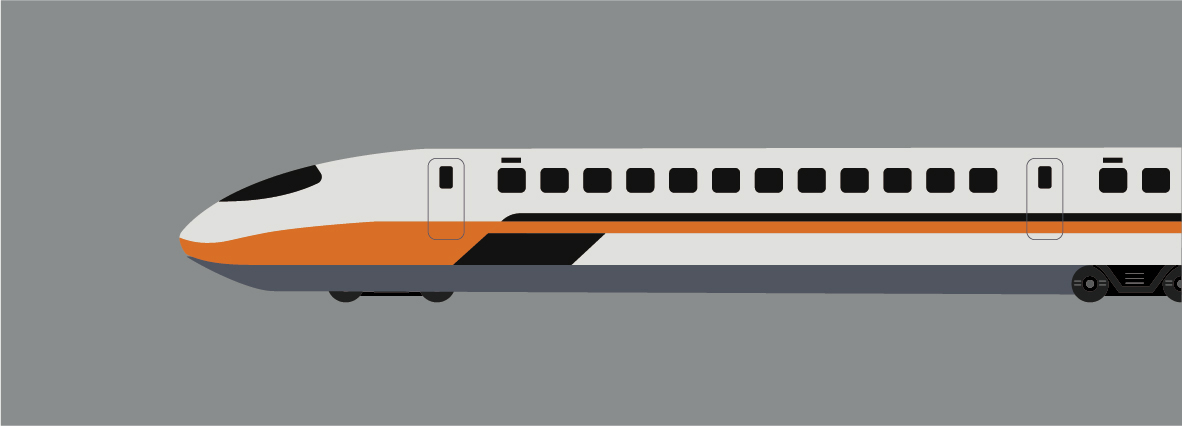
Exhibition
Exhibition
Exhibition
Exhibition
Public Chamber of High Speed Rail History - Taiwan High Speed Rail Archives
The Taiwan High Speed Rail Archives house a collection of over ten thousand historical artifacts related to the high speed rail, establishing the cornerstone of Taiwan's high speed railway cultural heritage. This initiative also marks the inception of a new strategy for preserving Taiwan's railway cultural assets and contributes to the development of a profound humanistic spirit within the high speed rail enterprise. However, the items in the archive have never been officially showcased to the public, with only a small number being loaned for exchange or display. Consequently, the High Speed Rail Archives have become akin to a "secret chamber of collections."
Due to the limited physical exhibition space currently available, Taiwan High Speed Rail aims to break away from the conventional design style typically associated with museum storage facilities. The High Speed Rail Archives will be presented in the form of a "public chamber," thereby serving the dual purpose of storage and exhibition. This approach not only accommodates the curiosity of museum visitors regarding storage facilities but also makes efficient use of the archive storage space, transforming it from an isolated vault into an accessible and engaging public space.
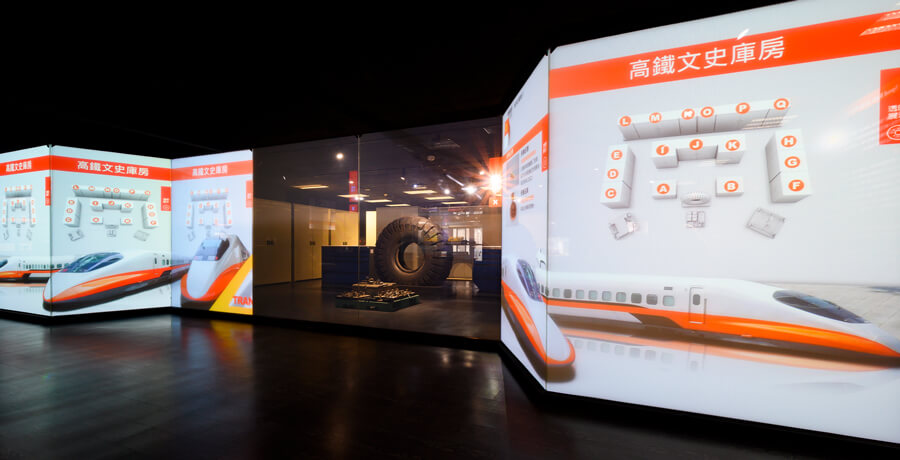

Operational Guidelines
The "Public Chamber" adopts advanced LCD electrochromic glass displays. Visitors may click on the "Transparent Display" button located at the upper right corner of each glass panel to transforms the originally opaque LCD glass into a transparent state, thereby allowing everyone to explore the interior of the Taiwan High Speed Rail Archives. Due to the strict temperature, humidity, and related environmental controls in the museum's archives, the use of electrochromic glass presentation method invites visitors to witness firsthand the contents and operations of the historical artifact storage facility.
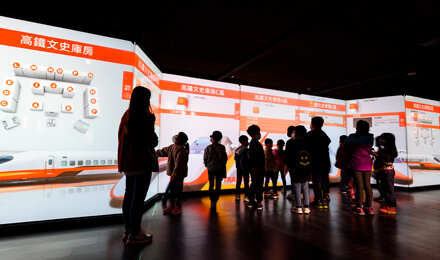
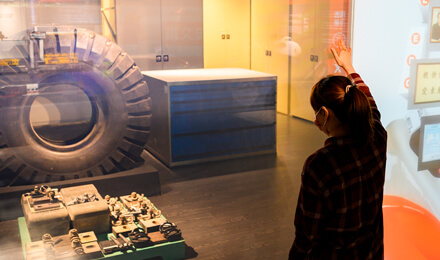
The Birth of Taiwan High Speed Rail
Inception - 2003
On October 16, 2003, in response to Chairman Yin's guidance, Taiwan High Speed Rail Company embarked on a comprehensive study and investigation project along the rail corridor, focusing on the rich historical treasures related to railways. This marked the beginning of a dedicated search for information concerning both "people" and "objects."
Taoyuan Era - 2004 - 2007
By 2006, a substantial number of historical artifacts had been amassed and stored in a rented facility in Taoyuan, in anticipation of the artifacts that would inevitably emerge during the operational phase. In August 2006, we entrusted the National Science and Technology Museum to formulate policies, classifications, and operational procedures for the preservation of high speed rail historical artifacts.
During the Taoyuan Era, our collection of Taiwan High Speed Rail historical artifacts was only temporarily logged and stored due to the mounting number of items and the unclear value of these collections. It became evident that we needed a diverse range of experts to assist us in establishing a comprehensive collection policy and management strategy. Consequently, Taiwan High Speed Rail Company enlisted the expertise of Museum Republic, introducing cutting-edge international artifact conservation techniques. This move officially laid the cornerstone for the preservation and maintenance of high speed rail historical artifacts.


Yanchao Phase - 2007 - 2016
In light of the inadequate hardware equipment at the Taoyuan THSR Historical Artifact Storage Facility and the necessity for optimal artifact conservation and preservation environments, we underwent a significant transformation. We relocated the High Speed Rail Historical Artifact Storage Facility to the THSR Yanchao Main Workshop.
On December 10, 2007, the Historical Artifact Storage Facility made its journey from Taoyuan to the THSR Yanchao Main Workshop, henceforth referred to as the "Taiwan High Speed Rail Yanchao Historical Artifact Storage Facility." This massive relocation project involved four separate moves for over 4,000 high speed rail historical artifacts and required the mobilization of numerous personnel and more than 20 vehicles, each capable of carrying 15 tons of cargo.
The "High Speed Rail Historical Artifact Storage Facility" found its permanent home within the embrace of its parent company, situated at the Yanchao Main Workshop. Museum Republic was entrusted with the task of revising our high speed rail artifact collection policy and executing artifact conservation work. This injection of a scientific approach into high speed rail artifact preservation led to the planning and development of an artifact collection management system. Each artifact received meticulous care, aligning with the standards of museum collection maintenance and firmly establishing the groundwork for the sustainable development of high speed rail artifact preservation.
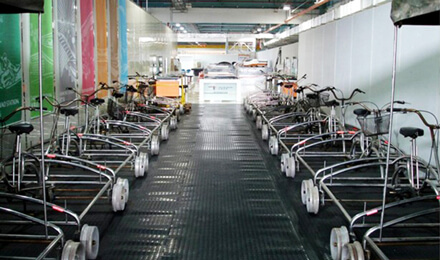
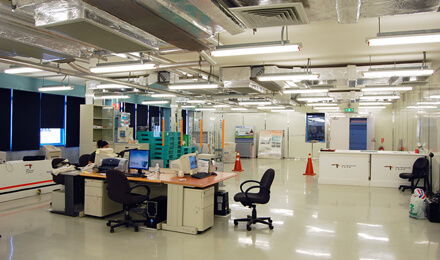
Taiwan High Speed Rail Museum Phase - 2016 - Present
After 13 years of dedicated artifact collection, the Historical Artifact Storage Facility embarked on yet another journey, this time from the Yanchao Main Workshop to the Taiwan High Speed Rail Museum in Taoyuan. The high speed rail historical artifacts, having traversed a decade of time and undergone the refinement of years, now grace the exhibition stage of Taiwan's high speed railway technology.
